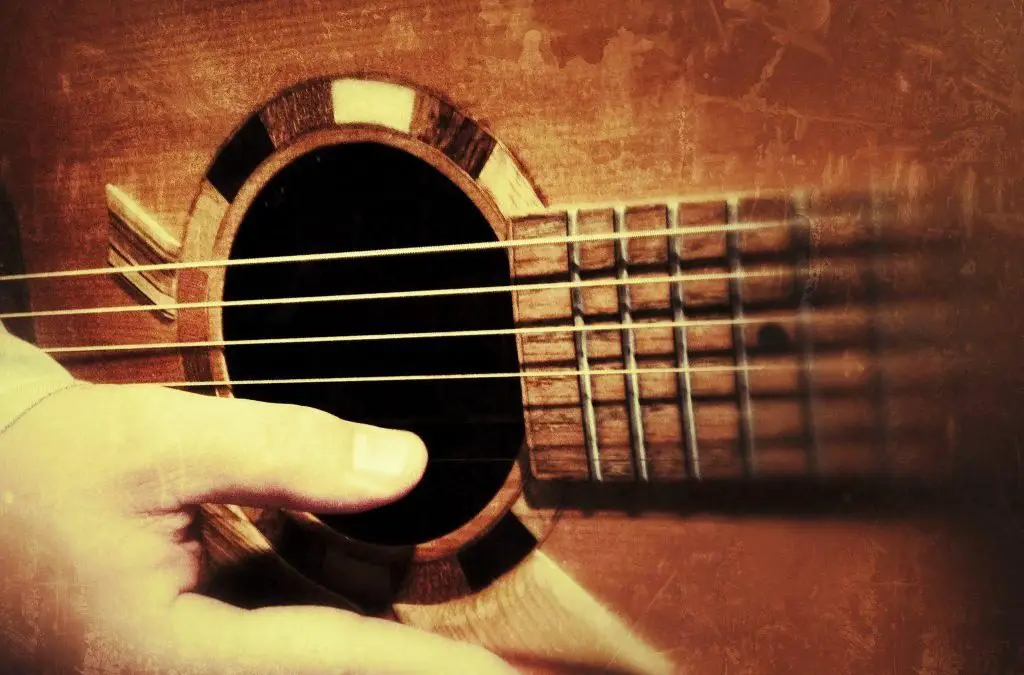Welcome to the world of acoustic guitar playing, where mastering the essential chords is the key to unlocking a whole new level of musical genius (or at least avoiding those dreaded sour notes). Whether you’re a beginner strummer or a seasoned picker, knowing your way around the fretboard is crucial for sounding like a true guitar virtuoso (or at least not scaring away your audience). So grab your guitar, tune up those strings, and get ready to dive headfirst into the wild and wonderful world of acoustic guitar chords. Let’s make some beautiful (or at least semi-pleasant) music together!
Contents
- 1 Understanding the Fundamentals of Acoustic Guitar Chords
- 2 Exploring Open Chords for Beginners
- 3 Transitioning to Barre Chords with Ease
- 4 Incorporating Fingerpicking into Chord Progressions
- 5 Advancing with Power and Add9 Chords
- 6 Perfecting Chord Transitions for Seamless Playing
- 7 Mastering the Art of Chord Embellishment and Variation
- 8 FAQs
- 9 Now go forth and strum like a boss!
Understanding the Fundamentals of Acoustic Guitar Chords
So you’ve decided to pick up the acoustic guitar and dive into the world of chords. Let me tell you, it’s a wild ride! But fear not, with a little understanding of the fundamentals, you’ll be strumming along in no time.
First things first, let’s talk about the basic building blocks of chords. A chord is made up of three or more notes played together to create harmony. In the world of acoustic guitar, there are a few essential chord types you need to master:
- Major Chords: These are the happy, upbeat chords that make you want to dance around a campfire. Think of them as the life of the party.
- Minor Chords: On the flip side, minor chords are the moody, introspective chords that make you want to stare off into the distance and contemplate the meaning of life.
- Seventh Chords: These bad boys add a bit of spice to your chord progressions. They’re like the unexpected guest who shows up to the party and steals the show.
Now, let’s talk about how chords are formed. Each chord is constructed using a specific formula of intervals, or distances between notes. It’s like a musical recipe – add a dash of this note, a pinch of that note, and voila, you’ve got yourself a chord!

Exploring Open Chords for Beginners
So, you’ve decided to take the plunge and start learning to play the guitar. Congratulations! Now, let’s dive into the world of open chords, shall we?
Open chords are a great place to start for beginners because they are easy to play and sound great. Plus, they are the building blocks for countless songs, so mastering them is essential. Let’s explore a few beginner-friendly open chords that will have you strumming like a pro in no time.
First up, we have the trusty G major chord. This one only requires three fingers and is a staple in the guitar world. Once you master this bad boy, you’ll be able to play songs by artists like Ed Sheeran and Taylor Swift.
Next, let’s tackle the versatile C major chord. This one is a bit trickier than G major, but with some practice, you’ll have it down in no time. With C major under your belt, you’ll be able to play classics by The Beatles and Bob Dylan.

Transitioning to Barre Chords with Ease
So, you’ve mastered your basic open chords and now it’s time to level up to barre chords. Don’t fret (pun intended), with a little practice and perseverance, you’ll be slaying those barre chords like a boss in no time!
Here are a few tips and tricks to help you transition to barre chords with ease:
- Proper Finger Positioning: Make sure your index finger is straight and presses down firmly across all the strings. Use the bony side of your finger, not the fleshy part, to get a clean sound.
- Practice Makes Perfect: Start by practicing on the lower frets where the strings are easier to press down. Gradually work your way up the fretboard as your fingers get stronger.
- Pamper Your Fingers: Barre chords can be tough on your fingertips, so take breaks to let them recover. You can also try using a lighter gauge of strings to reduce the pressure on your fingers.
Remember, Rome wasn’t built in a day, and neither were perfect barre chords. Keep working at it, and soon enough, you’ll be rocking out like a pro!

Incorporating Fingerpicking into Chord Progressions
Fingerpicking can add a whole new dimension to your chord progressions. It’s like giving your guitar an extra set of magical fingers. So let’s dive into how you can sprinkle some fingerpicking magic into your chord progressions.
First things first, make sure you’ve got your basic chord progression down pat. You can’t fingerpick your way out of a bad chord progression. Once you’ve got that sorted, here’s how you can incorporate fingerpicking:
- Start simple: Don’t try to master The Beatles’ entire discography in one day. Start with simple patterns like alternating between the bass note and strumming the rest of the chord. Keep it easy peasy lemon squeezy.
- Experiment with different fingerpicking patterns: There’s a whole world of fingerpicking patterns out there waiting to be explored. Try out patterns like Travis picking, arpeggios, or whatever wacky finger acrobatics you can come up with.
Remember, practice makes perfect. So don’t get discouraged if your fingers feel like they’re doing the cha-cha when they should be waltzing. Keep at it, and soon enough, you’ll be fingerpicking like a pro.

Advancing with Power and Add9 Chords
So you want to take your guitar playing to the next level, huh? Well, buckle up, because we’re about to dive into the world of power chords and add9 chords!
Let’s start with power chords – the go-to for any rock star wannabe. These bad boys are like the Chuck Norris of chords – simple, yet powerful. Just two notes played together to create that crunchy, distorted sound that will make your audience beg for an encore.
Now, onto add9 chords - the fancy-pants cousin of power chords. These babies add an extra layer of sophistication to your playing, like adding a top hat to a tuxedo t-shirt. They’re like the secret sauce that takes your chord progressions from basic to badass in seconds.
So, whether you’re shredding on stage or strumming in your bedroom, mastering power and add9 chords will give you the edge you need to stand out from the chord-strumming crowd. Now go forth, young guitarist, and conquer the fretboard with your newfound knowledge!
Perfecting Chord Transitions for Seamless Playing
Now, we all know that mastering chord transitions is like the Olympics of guitar playing. It’s that moment when you smoothly glide from one chord to another without missing a beat. It’s like dancing on air! But let’s be real, sometimes our transitions can be as clunky as a robot trying to breakdance.
But fear not, fellow musicians! With a little practice and the right techniques, you can perfect your chord transitions and become a seamless playing pro. So, grab your guitar and let’s dive into some tips that will have you transitioning like a boss in no time.
First things first, make sure your fingers are properly positioned on the fretboard. **Proper finger placement is key to smooth transitions,** so take the time to ensure your fingers are in the right positions before making any movements. Remember, practice makes perfect!
Next, work on your muscle memory by practicing transitioning between two chords repeatedly. **Repetition is your best friend when it comes to mastering chord transitions,** so don’t be afraid to spend some quality time with those tricky chord changes. Before you know it, your fingers will be moving between chords like a well-oiled machine!
Mastering the Art of Chord Embellishment and Variation
So, you’ve mastered the basic chords and now you’re ready to take your playing to the next level by adding some flair and spice. Embellishing and varying chords can really elevate your sound and make you stand out from the crowd. Here are a few tips to help you become a chord embellishment wizard:
- Experiment with different voicings – try playing the same chord in different positions on the fretboard to create a more interesting sound.
- Don’t be afraid to add extra notes – throw in some sevenths, ninths, or even some suspensions to add flavor to your chords.
- Get creative with strumming patterns – changing up your strumming technique can completely transform the way a chord sounds.
One of the best ways to master chord embellishment and variation is to learn from the pros. Study the playing of guitar gods like Jimi Hendrix, John Mayer, or Joni Mitchell and take note of how they spice up their chords. And remember, practice makes perfect – the more you experiment with different embellishments and variations, the more confident and creative you’ll become in your playing.
So grab your guitar, unleash your inner rock star, and start experimenting with chord embellishment and variation. Who knows, you might just discover a sound that’s uniquely yours and take your playing to a whole new level.
FAQs
What are the essential acoustic guitar chords a beginner should learn first?
Well, my friend, if you’re just starting out on your acoustic guitar journey, you’ll want to get cozy with the classic chords like G, C, D, and E minor. These bad boys will serve as the foundation for countless tunes, so get comfortable with ’em!
How can I improve my chord transitions?
Ah, the age-old question. Practice, practice, practice! Start slow and focus on getting each finger in the right position before speeding things up. And don’t be afraid to throw in some fun chord transition exercises to keep things interesting!
What are some tips for mastering barre chords?
Oh, barre chords. The bane of every beginner’s existence. But fear not! To conquer these bad boys, make sure you’re using proper finger placement and applying just the right amount of pressure. And remember, practice makes perfect!
How can I spice up my chord progressions?
Ah, looking to add a little pizzazz to your playing, eh? Try experimenting with different variations of the basic chords, adding in some cool embellishments, or even throwing in some fancy inversions. The world is your oyster, my friend!
What are some common mistakes to avoid when learning acoustic guitar chords?
Oh, where do I begin? Make sure you’re not sacrificing proper finger placement for speed, avoid developing bad habits like poor wrist positioning, and for the love of all that is musical, don’t neglect your pinky finger! Trust me, it’ll thank you later.
Now go forth and strum like a boss!
So there you have it, folks! With these essential acoustic guitar chords under your belt, you’re well on your way to becoming a strumming sensation. Remember, practice makes perfect - so keep on playing those chords until your fingers are sore (and then play some more). Who knows, maybe one day you’ll be the next guitar hero, serenading audiences with your sweet chord progressions. Until then, keep on rocking and keep on mastering those chords. You got this!



